WiMAX Equipment at Computex Taipei Shows Wireless Mobility Maturing
2009/06/17 | By Ken LiuExplaining why WiMAX (Worldwide Interoperability for Microwave Access) integrated devices exhibited at the Computex Taipei show this year far outnumbered that last year, Lonnie McAlister, product line manager of the Taiwan branch of Intel Microelectronics Asia Ltd., said: "Because every WiMAX thing is mature."
"Not only infrastructure equipment but also [end-user] devices themselves are mature. WiMAX has been cooking over the past 12 months [since Computex 2008]. Now we are seeing real performance, very stable result [of WiMAX equipment]," he stressed in an interview with the China Economic News Service (CENS).
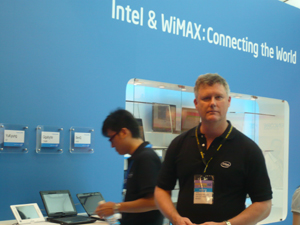
WiMAX integrated devices, mostly notebooks, netbooks, electronic books, and even handsets, have come to the market quickly thanks to the inventions of WiMAX-integrated wireless chip module, according to McAlister. Intel Echo Peak is said to be the first Wi-Fi/WiMAX-integrated module available since September last year.
Taiwan supplies 90% of world's WiMAX consumer-premise devices, so most of the integrated equipment comes from Acer, Asustek Computer, VIA Technologies, Inventec, HTC, Cheng Uei Precision and Quanta Computer.
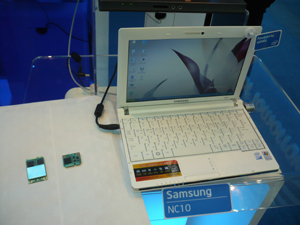
Open Patent Alliance
Acer is offering several WiMAX-integrated notebooks and netbooks, including the Acer Aspire and Acer TravelMate. The world's No.3 PC maker in May this year joined the Open Patent Alliance (OPA), a group formed in June 2008 by members of WiMAX suppliers to offer intellectual property rights (IPR) solutions that support the development and widespread adoption of WiMAX.
"As the first global PC OEM to join the OPA, we hope to lead the charge in bringing several devices that harness the power of WiMAX wireless broadband technology to the hands of consumers worldwide," said Jim Wong, senior corporate vice president and president of IT Products Global Operations, Acer.
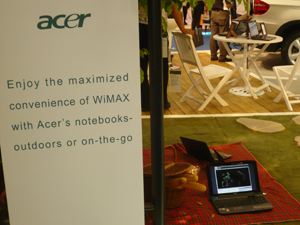
This year's Computex saw surging numbers of WiMAX exhibitors, rising to 700 from around 250 last year: Cheng Uei exhibited WiMAX-integrated mobile Internet devices (MIDs), VIA displayed WiMAX netbooks, Elitegroup unveiled WiMAX mobile phones and Inventec showed off its WiMAX-enabled e-books; while HTC has delivered WiMAX mobile phones to the Russian service provider Yota.
Inventec will make its electronic books available at the end of this year. Now it is working with chip designer MediaTek and cellphone maker Motorola to develop WiMAX-enabled mobile phones, which Inventec plans to debut at yearend. MediaTek has recently launched three 802.16e WiMAX chips, with one for mobile phones and integrated devices and the other two for Malaysian service provider Packet One's household WiMAX antennas.
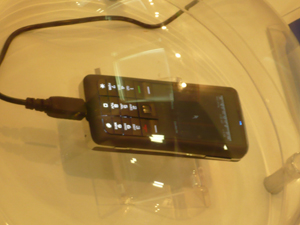
Chief Executive R.H. Lin of GemTek Technology, which supplies household WiMAX antennas and integrated modules, said that shipment of WiMAX integrated notebooks would grow annually at a double-digit rate worldwide based on Intel's determination to push the latest broadband wireless technology as it did with WiFi.
Taiwan's WiMAX equipment makers will generate revenues of above NT$10 billion (US$303 million at US$1:NT$33) to NT$13 billion (US$393 million) this year, up from 2008's NT$6.1 billion (US$184 million), according to the Ministry of Economic Affairs (MOEA). The growth projection is in line with a bright forecast Intel released during 2009 Computex, which estimates around 100 models of WiMAX/Wi-Fi integrated modules will be shipped worldwide by the end of next year, surging from 2008's 26 modules.
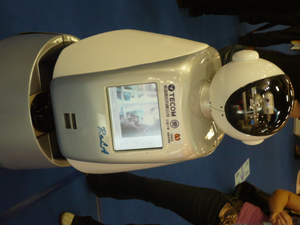
Surging Demand
"So there will be a big uptake in WiMAX demand. And that's the result of WiMAX-integrated notebook, which is a perfect marriage. We should see a pickup in notebook sales," McAlister said. "In the United States, they have launched over 35 [WiMAX-enabled] notebooks. In Russia, they have over 30 devices, even a GSM/WiMAX dual-mode handset."
Industry officials estimate equipment manufacturers will get a big boost from a recent decision by the US-headquartered WiMAX Forum to reduce its fee to test compatibility and interoperability between WiMAX equipment to US$1,000-2,000 a case from US$30,000-130,000.

"So the [WiMAX] device setting is really healthy at this point. It's just a matter of service providers rolling out their networks. And now the effect of commercial deployment is showing up. The key is getting the networks out there and driving consumer's interest," McAlister said.
The Intel Microelectronics product line manager noted that WiMAX service is available now in South Korea, with commercial launch across the entire country. In Japan, service providers are planning to cover 77% of population this year and 90% next year. Clearwire in the U.S. is looking to cover 35 million to 70 million people by the end of this year. In Russia, Yota is expanding its network coverage. "And we got new deployments coming along down in Malaysia, Europe, South America and the Middle East. All the new networks are just coming up. It takes time. It really depends on speed of the network," he said.
Global Deployment
According to Intel's press release, over 450 WiMAX networks are already deployed in 136 countries serving 430 million subscribers worldwide, and around 50 countries are deploying the networks in preparation for an estimated 800 million subscribers worldwide by the end of next year.
In Taiwan, the government has issued six WiMAX licenses and spent NT$37 billion (US$1.1 billion) setting up infrastructure for fourth-generation mobile connection. After infrastructural construction, the government will shift its WiMAX investment to the content industry and has pledged to budget NT$800 million (US$24 million) to develop digital content available for downloads on the WiMAX network.
Following Tatung Infocomm Co., Ltd., Taiwan's other licensed service providers will enter into alliance with big WiMAX players, including Intel and Clearwire Corp., to start the service by the end of this year.
Tatung in the Game
Tatung is said to be working with Intel in an upcoming capital raising. Informed sources say Intel plans to ally with a local WiMAX provider with coverage in southern Taiwan after investing in VMAX Telecom Co., Ltd., which is licensed to serve northern Taiwan.
Tatung began offering WiMAX service in Penghu Islands off Taiwan in April this year and will eventually cover all of Taiwan, which will be achieved by partnering with providers serving northern Taiwan.
Chairperson W.Y. Gou says Tatung will invest NT$5 billion (US$151 million) over the next five years to develop new WiMAX services as delivering remote medical treatment, home security and elderly care.
Tatung, an affiliate of Taiwanese household-appliance manufacturing conglomerate Tatung Corp., plans to sign up 60,000 subscribers by the end of this year and one million subscribers in five years. Its general manger, F.H. Yen, pointed out that WiMAX beams data online at 10 megabit per second, speedier than 3.5G technology and relatively less expensive. The company now has around 14,000 subscribers on a trial basis.
Intel bought a 19% stake in VMAX for NT$386 million (US$11 million) last year, as part of its commitment to spending at least US$500 million in five years on Taiwan's WiMAX business. The company will launch service in the fourth quarter.
"Intel's investment in VMAX focuses on connecting VMAX to other WiMAX operators running on the Intel format and preventing VMAX from moving in the wrong direction, rather than as a capital investment," emphasized VMAX President T.T. Huang.
Live WiMAX Demo
To prove to visitors the power of the broadband wireless technology WiMAX, VMAX had a robot connected to its network patrolling the company's booth. According to the controller, the robot was demonstrating remote healthcare and surveillance via WiMAX, whereby a web camera and computer screen were used. "The web camera captures images to send the streaming video to the doctor at the other end in this case, with the screen showing the medical treatment being dispensed. All are done on the WiMAX network," he said. The robot, the controller noted, shows how good WiMAX is connected to the Internet on-the-go.
Clearwire, currently the world's No.1 WiMAX-service provider by operational scale, has decided to buy into Global Mobile Co., Ltd. in two phases, with the first-phase investment estimated at NT$20 million (US$606,000), according to Global Mobile chairperson Rosemary Ho.
Global Mobile will begin to launch the service in September this year in Hsinchu, where it will install 100 cell towers. It will spend NT$500 million (US$14 million) on equipment initially and raise the spending to NT$3 billion (US$85 million) eventually.
Vee Telecom Multimedia Co., Ltd., owned by a leading cable-TV operator in central Taiwan, will sign a deal to sell its stock to Clearwire in mid-June to enter into an alliance. The partnership will see Vee Telecom likely to work with Clearwire to promote WiMAX roaming services globally, and acquire technical support from the American firm to upgrade its WiMAX technologies.
Taiwan's WiMAX providers will mostly serve households to upload/download digital content, offer remote healthcare, news broadcasting, surveillance, and GPS navigation. They will adopt a business model similar to that used by existing telecom-service providers: offering free end-user device bundled with service fee. All of these service providers displayed WiMAX-integrated gadgets along with several Dongle cards at the Computex Taipei.
Fast but Cheap
WiMAX is enticing for several reasons. WiMAX Forum President Ron Resnick once touted WiMAX as "the first technology that allows true mobile Internet speed wherever you go wireless." In addition to its efficient data upload/download, around one-to-three megabit per-second on-the-move at speeds of 80 to 105 kilometers per- hour and 10 Mbps while stationary, on the Internet, WiMAX, McAlister noted, provides low cost data. "There is less IP structure, no royalties or low royalties. It goes through the industry certification process. So, that means a lot of people can compete and drive the cost down. That's what WiMAX promises to bring. You can't get that in 3G and you probably won't get that in LTE [Long Term Evolution] either because it still has an IP royalty structure."
Although the economic recession has taken a toll on WiMAX deployment, McAlister still feels optimistic about the market. "Everyone has been impacted by the recession, which has caused service providers to slow some of their network deployments. However, those who have funding and capital are still moving forward. For instance, we have Penghu Island launch with Tatung Infocomm this year. VMAX and Global Mobile, both of them launching this year as well. If the financial backing is there, there is no reason to stop even with the global economy the way it is," he said.
Regardless of the recession, Intel, according to one of its sales representatives at the Computex Taipei, will introduce more powerful WiMAX chipset modules, with its Kilmer Peak scheduled to roll out in the fourth quarter this year and Evans Peak to hit the market in January next year. Operating in the spectrum of 2.5GHz and 3.5GHz as well as offering bandwidth of 5.10 megabits per-second, Evans Peak is specifically developed for mobile phones. Kilmer Peak is a 2.3GHz, 8.75 Mbps product. The two modules will definitely further boost the embedment market thanks to more powerful performances.

